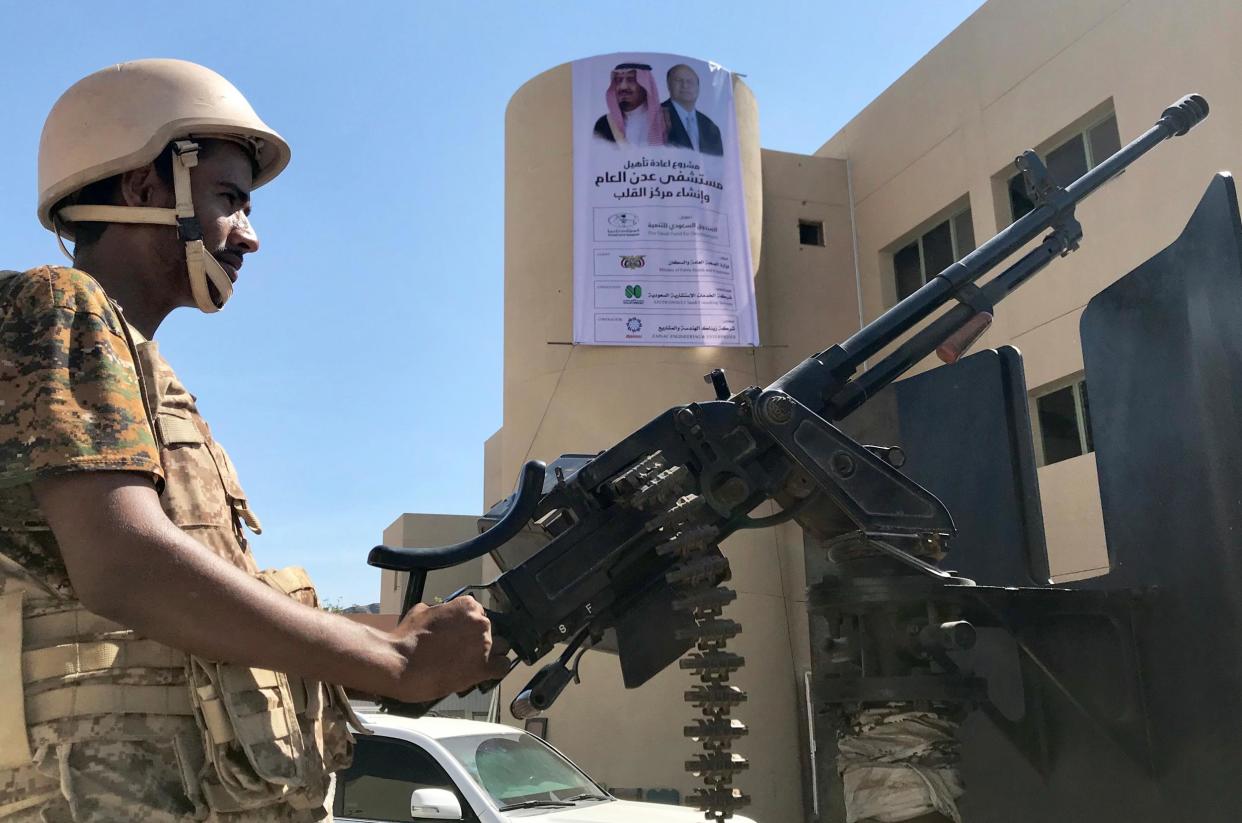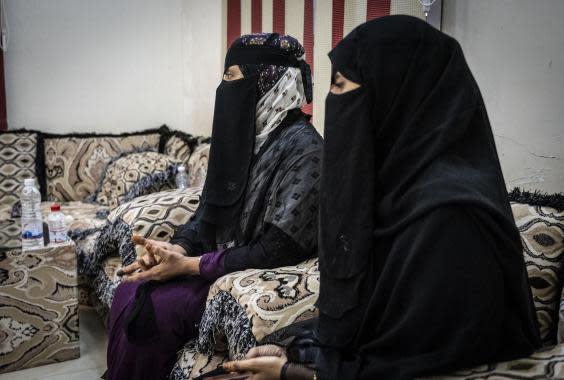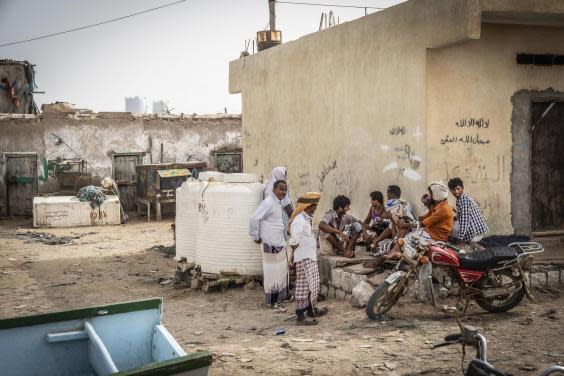Inside east Yemen: the Gulf’s new proxy war no one is talking about

The bullet had punched a hole kidney-height through the driver’s side of the pick-up truck. Another two, neat as bellybuttons, perforated the top of the window.
But for some reason a tidy shoulder wound was the only injury Salem Balhaf, a retired Yemeni soldier from the east, had sustained in the firefight.
He shrugs it off with a cheek full of qat.
“They opened fire at a flying checkpoint they set up on the main road,” he says, spitting green into a pink plastic bin.
“The Saudis and their forces were up to something last night,” he adds with a grin.
Salem is one of hundreds of Yemeni tribesmen who over the last year have clashed with Saudi Arabian forces and its affiliates in Mahra, a province that prides itself on its autonomy, culture and unique language, but is now the front line of a new and little-covered proxy war.
Men and women have staged regular protests against what they deem to be an “occupation” of their lands by Riyadh, that is spearheading a military coalition fighting the Iran-backed Houthi rebels on the other side of the country.
Isolated by yawning ravines and sweeping moonscapes, Mahra, Yemen’s most eastern province, had been spared the horrors of the five-year war that was triggered by the Houthis ousting the recognised Yemeni government.
It has also, until recently, seen little presence of extremist groups like al-Qaeda and Isis.
But since late 2017, the often-forgotten region found itself embroiled in Yemen’s newest proxy war between Gulf countries. The Saudis began shuttling as many as 1,500 troops to the area, according to Yemeni researchers, and training local forces to tackle rampant weapons smuggling through the porous border with Oman.
Just days after the arrival of Saudi forces, Mahra’s governor Mohammed bin Kuddah, who tried to push back, was replaced by Saudi-chosen candidate Rajeh Bakrit, a figure who had spent comparatively little time in Mahra and who landed in January 2018 in a Saudi plane.
Despite initially promising not to, Riyadh took over and shut down Mahra’s civilian airport, turning it into a military headquarters. The Saudis unfurled a further five main bases, some still under construction, and according to locals as many as 20 smaller outposts – sparking alarm and outrage among the Mahri who accuse the Saudis of a land grab.
The Saudi authorities have repeatedly defended their actions, saying heavy weaponry was being funnelled through Yemen's long sea coast or even through the border with Oman to Houthi rebels who were firing missiles at Saudi Arabia that were reaching as far as Riyadh.
Saudi presence has not just agitated the locals but, according to experts and foreign diplomats, caused a growing rift with neighbouring Oman, another regional powerhouse.
Muscat sees the takeover of its neighbour Mahra, as a domestic threat: many Omanis are Mahri and tribal territory stretches over the border with Yemen.
Experts and officials have warned that Oman, once dubbed the Switzerland of the Middle East for its refusal to take sides in any conflicts, has recently started funnelling financial support to their own affiliates on the ground. British diplomats in interviews with The Independent also voiced their concern about Muscat’s entry to the complex proxy war.
The resulting tensions have received little international attention, but could have wide-reaching and potentially devastating consequences for the region if both sides continue to fight for control of the area.
“Mahra was isolated and the last stable place in Yemen. But now there is a regional power war brewing and Mahra is the new proxy front line,” said Farea al-Muslimi, head of Yemeni think tank Sanaa Centre for Strategic Studies.
The think tank’s own researcher, local journalist Yahya Sawari, was arrested on 3 July by Saudi-affiliated forces while attempting to interview anti-Saudi protesters injured during rallies which were attacked.
Neither the centre nor Sawari’s family had any idea where he was being held or on what charges. The Committee to Protect Journalists called for his immediate release.
On Tuesday, more than 50 days later, a message appeared on Sawari’s Facebook page, where he said he managed to get out but had been tortured into confessing he worked for Qatar or Oman and his brother was still missing.
One of the dynamics Sawari had been researching was how the Saudi power grab has dragged Oman into the melee.
According to al-Muslimi, and conversations The Independent had with Mahri tribesmen, Oman is now actively sending money to forces within Mahra to ward off a total take over. Oman has also been accused of encouraging anti-Saudi protest movements there.
“Oman was the last neutral neighbour for Yemen. It was not involved in this war but now it is,” he adds.
Officials within Oman declined interviews. However, sources close to the government, told The Independent that the Omani leadership is taking an increasingly strong stance against Saudi encroachment in Mahra.

Dr Abdullah al Ghailani, an Omani strategist, tells The Independent from Muscat that Mahra was “Oman’s backyard”.
“We have also developed a lot of infrastructure there, we have strong political ties. Mahra is the buffer zone which remained a peaceful place until the Saudis and UAE put their troops there,” he adds.
It has also potentially set the Saudis against their regional ally the UAE. Abu Dhabi reportedly tried and failed between 2015 and 2017 to build and train a Mahra elite force, ostensibly to fight extremist groups like al-Qaeda as they had done in other governorates including Aden, home to the country’s de-facto capital.
In the process, the UAE set up a sweep of bases along the southern coastline of the rest of the country.
Oxford University professor Elisabeth Kendall, a leading expert on Mahra, says the Saudi’s military footprint in Mahra would “stop the UAE from getting a clean sweep of the south”.
“If they have their military bases, it is going to mean that the UAE can’t have a separate south, as they won’t get Mahra and Socotra,”
She points to the fact that the Saudi campaign to stop smuggling hasn’t put a complete halt to the trade.

“Certainly, Saudi went in to tackle smuggling but they don’t look like they are leaving. And while they have tackled the big stuff they have left the smaller stuff,” she adds.
Yemen has been ripped apart by a ruinous civil war since the Iran-backed Houthi rebels swept control of the country in early 2015, ousting the recognised president Abed-Rabbou Mansour Hadi.
Fearing the encroachment of Iranian influence on its borders, Saudi Arabia and its Sunni allies, including the UAE, launched a devastating bombing campaign in March of the same year to reinstate Mr Hadi.
As the war dragged on they launched a ground invasion and Abu Dhabi trained up some 90,000 Yemeni troops to battle the Houthis, but also snuff out a growing presence of al-Qaeda and Isis that exploited the security breakdown to expand their territories.
Five years on there is little hope for an end to the crisis, which has left nearly 13 million people on the brink of famine.

And now from the ashes of the war, several separate wars are bubbling up, including one for southern independence fuelled in part by the Gulf empowering separatist forces in the west of the country.
A brewing conflict in Mahra, a province dismissed for being over 850km away from the well-worn frontlines, has passed largely under the radar until now.
Historically Mahra has enjoyed independence. Up until 1967, it was part of a 450-year-old sultanate which included the Unesco-protected Socotra archipelago.
After a period as a British protectorate in the 1960s, it unwillingly became part of separate South Yemen, before that was unified with the north in 1990.
The Mahri tribes, who speak their own unique language, have retained a strong sense of independence and, other than hosting displaced families, largely steered clear of the Yemen war until it landed on their doorstep recently.
“The thing we are worrying about the most is that the Saudi occupation will take more land and become violent,” said Nadra Mohammed, 30, a teacher, who has for a year spearheaded a women’s protest movement against the presence of Saudi forces in Mahra’s capital Ghaydah.
The women’s rallies are also fighting a recent influx of Salafists fleeing war in other parts of the country, who first appeared after the Saudis set up their main base in the airport.
The women believe the Salafists have been encouraged by the Saudis to move to Mahra, a province which, although religiously conservative, is vehemently against extremist interpretations of Islam and sees Salafism as a threat to their way of life.
This is our biggest worry – if the situation continues there will be a war here
Nadra Mohammed 30, protester
Nadra, a mother-of-four, said men’s protests, similar to the women’s movement, had been met with force and claimed that at least three people had been arrested and disappeared.
“This is our biggest worry – if the situation continues there will be a war here,” she says nervously.
In November 2018, two people were killed during a protest by local tribesmen, which was attacked by Saudi-backed forces who got into a firefight with locals.
Recently the Saudi coalition in Mahra has begun using Apache helicopters to intimidate protesters – just the week before The Independent entered Yemen, they had fired warning shots near to Ghaydah city.
The Saudis and their affiliated forces deny they have shown any violence. They dismiss the protests saying they are orchestrated by disgruntled and corrupt tribesmen who have been pushed from power in the battle against smuggling.
Some critics have accused the protests of being backed by Muscat, an accusation the women vehemently deny.
Nadia’s brother Hazem Kudda, 28, claims he was briefly detained by the Saudis authorities in the airport, questioned about his sister’s role in the protests, and urged to sign a document promising not to continue with the rallies.

“They told me to tell my sister she should stop going to the sit-ins, they finally released me after 10 hours when a tribal sheikh intervened,” he says.
“The airport is like a village, full of armoured cars and weapons. There will be a conflict between the tribes, if they keep arresting tribal members I think there could be war,” he adds.
Outside of the protest movement, and the overlapping political allegiances, there is a rising sense of anger among regular locals.
At Mahra’s main hospital, near to a sign reading “no qat and no machine guns” families, completely unprompted, talk of the rise in numbers of “militias” and arrests.
“We are very worried about the situation with this new army from outside,” Abdalla, 40, says referencing the Saudi-trained local forces, many of whom hail from governorates across the country.
His was visiting an elderly female relative in the hospital’s women’s ward and interrupted a different interview The Independent was conducting to talk.
“We had been living in peace until recently. They come and arrest people from their houses, apparently accusing them of being agitators or extremists.”

“It feels like it might explode at any time because of the tensions. These people have a strong hand, they seem to have the control now,” he adds.
Across town at one of Mahra’s battered fishing villages, fishermen dressed in scrubby Yemeni izaars or traditional sarongs, complain that they are not permitted to fish around the new Saudi bases.
They say they have been hounded by the Saudis over allegations they are involved in the lucrative sea smuggling trade, a real problem that has blighted the country, that was already awash with weapons.
Some like Saad Abdulla, 30, said their fishing stores were violently raided, only ratcheting up tensions.
“Our daily earnings have tanked to about three quarters of what we had before because of the zone restrictions,” said Abdulla, a father-of-three whose fishing village is three kilometres east of Ghaydah.
“If we were smugglers we would have lots of money, we wouldn’t be sitting in a small tub trying to fish,” he added.
Disgruntled former regional officials, who like the governor were sacked in place of the Saudi’s preferred candidates, claim the power grab is part of efforts for Saudis to build an oil pipeline from its territory to the Arabian Sea, an idea which has been floating for decades.
They say Saudi Arabia is increasingly penned in since May drone attacks on its crude oil pipelines, a crisis in the major waterway the Strait of Hormuz and the Houthis threatening the Bab-al Mandeb Strait on the other side of the peninsula.

“Since the crisis in the Strait of Hormuz, we have noticed the Saudis have bought more weapons and upped control over the border. They have also increased their recruitment of local forces,” says Ahmed Mohammed Qahtan, the former chief of police for Mahra, from Muscat.
He was among the Yemeni officials who tried to prevent the Saudis from taking over the airport. Pro-Saudi factions accuse him of being corrupt and agitating the protest movement.
“They want to export oil for these areas via the Arabian Sea to avoid the Strait of Hormuz tensions. The used the pretence of stopping smuggling and terrorism,” he adds.
Qahtan, who is largely based in Muscat these days, does not mince his words: “We wish to get a decision by the UN to order the UAE and Saudi to leave Yemen in 30 days. We would prefer Israel to the people there now.”
His right-hand man is controversial figure Ali Salem al-Huraizi, who is a former border chief and deputy governor, known by his loyal supporters as “the general”.
Since the time of toppled President Ali Abdullah Saleh, the tribal leader, who has become a key figure in the anti-Saudi protests, has been dogged by allegations of involvement in smuggling, which he vehemently denies.
He does however publicly acknowledge the support provided to him by the Omani government.
We wish to get a decision by the UN to order the UAE and Saudi to leave Yemen in 30 days
Ahmed Qahtan, former chief of police in Mahra
He too believes at the heart of Saudi’s presence in Mahra is oil and strategic territorial land grabs, claiming his tribesmen found engineers guarded by Saudi-backed troops trying to put down markers for a pipeline.
“The Saudis want to exploit hundreds of thousands of barrels of oil through Arabian Sea ... We have seen them recently putting down markers for a pipeline, we caught them and took their guns,” he added.
Whatever the truth is, the outcome is the same: yet another conflict within Yemen’s already ruinous war.
Back at the bullet-riddled pick-up truck, Salem packs his rifle into the front seat. With an RPG in the back, he is ready to head out.
“The Saudi and Emirates planted militias here and they will start a civil war and that war has started.”
Read more
The war to start all wars: Inside Yemen’s troubled south
UK licenses £6.2bn of weapons to Saudi coalition during Yemen war
US drone ‘shot down over Yemen’
What now for the Saudi-UAE alliance in Yemen?
New report alleges Saudi Arabia covered up war crimes in Yemen

